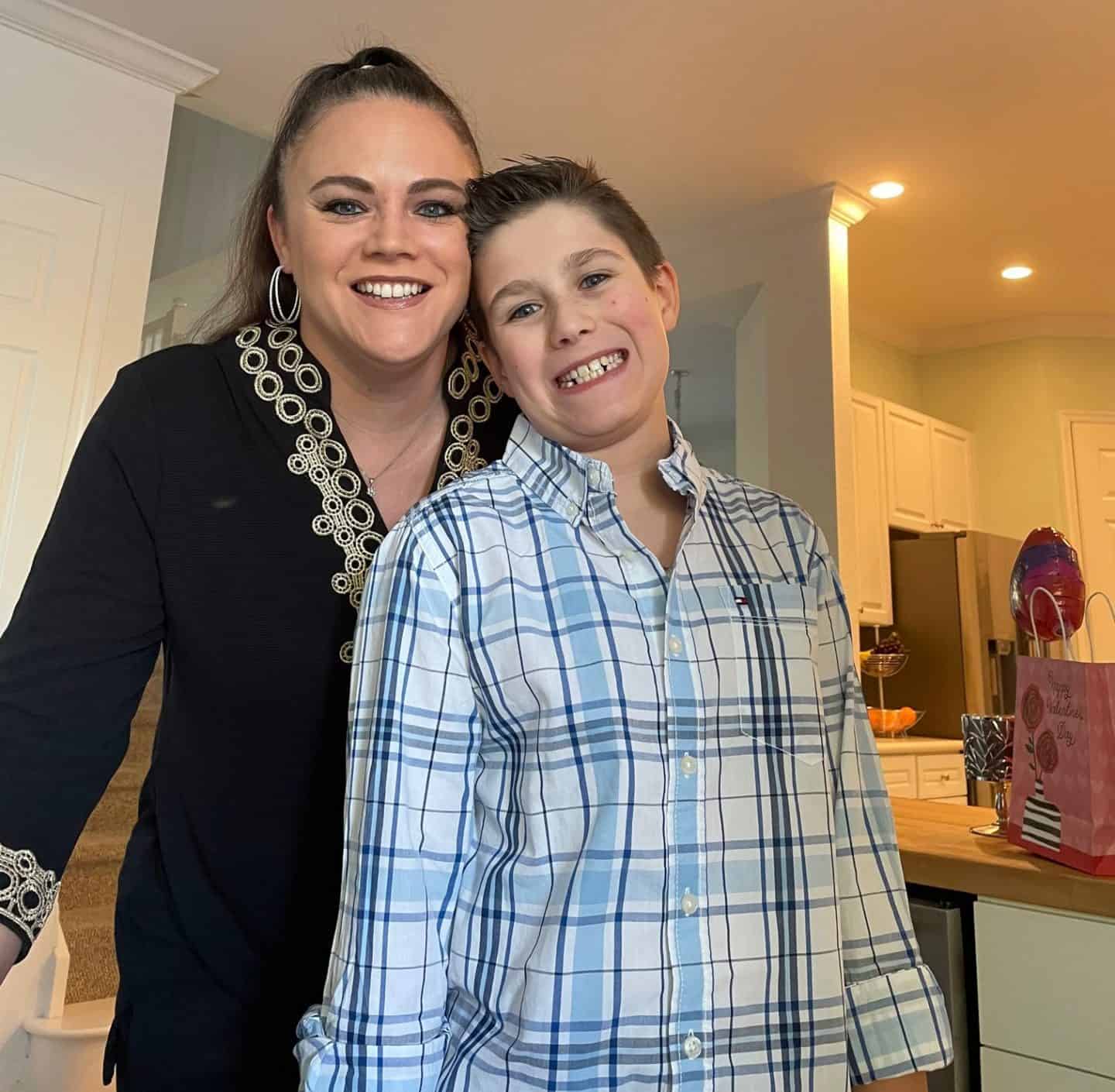Why Homeschooling An Only Child Is Awesome!
Homeschooling an only child definitely comes with its own set of challenges—and rewards.
As a homeschool of 1, I’ve lived through the ups and downs, from figuring out social opportunities to customizing every part of our day around one kid’s needs.
If you’re starting out or just looking for reassurance that you’re not alone in this, I hope our experience helps.
It’s not always easy, but it’s been the right fit for us, and I’ve picked up plenty of tips along the way.

**This post may contain affiliate links. As an Amazon Associate and a participant in other affiliate programs, I earn a commission on qualifying purchases.**
What Homeschooling Looks Like in Our House
When we first started homeschooling, I quickly realized there’s no one-size-fits-all approach—especially with an only child.
Some families follow a full curriculum from day one, others take a more relaxed, interest-led route. We’ve tried a bit of both over the years, adjusting as we go.
For us, it’s been about creating a rhythm that fits his learning style and keeps things enjoyable for both of us.
One of the biggest perks of homeschooling an only child is the freedom to make it truly personal—and that’s made all the difference.
Why We Chose to Homeschool an Only Child
Our decision to homeschool came from a mix of reasons—some big, some practical. Public school just wasn’t the right fit, and we wanted more flexibility, more time together, and more say in what and how he was learning.
One of the things I’ve really come to appreciate about homeschooling an only child is how focused it can be. I get to tailor everything to his pace and interests. There’s no waiting on a class or rushing to keep up—we move as fast or as slow as he needs. It’s also given us a chance to travel more, try new things, and turn everyday moments into learning opportunities.
It’s not without its tough days, but knowing he’s in an environment that supports him fully makes it all worth it.
What Our Days Look Like (and How We Pick Curriculum)
Homeschooling my only child has been one of the most rewarding things I’ve done.
We spend so much time together—learning, talking, figuring things out—and that one-on-one connection has made a huge difference in how he learns and how we relate to each other.
Some days are smooth, others not so much (especially when motivation is low or a subject just isn’t clicking), but overall, the freedom to choose what works for him has been key.
We’ve switched things up a few times over the years—sometimes we follow a structured plan, and other times we lean into more hands-on or interest-based learning.
We’ve used Christian programs like Abeka and Sonlight, but mainly stuck to secular options like Pandia Press and Khan Academy. It’s a bit of trial and error, but that’s part of what makes it work—you can adjust until it feels right.
What About Socialization?
This is the question I get asked the most—and honestly, it was one of my own biggest concerns at the beginning.
Being an only child means there aren’t siblings to play or learn with, so we’ve had to be more intentional about creating social opportunities.
Most of his friends are in public school, so we work around their schedules for playdates and hangouts.
He’s also involved in sports and music lessons, which give him regular time with other kids. And we’ve joined local homeschool groups and co-ops over the years—those have been great for both of us.
Is it perfect? No. Some days he gets lonely, and we talk about that. But we’ve found a rhythm that works, and he’s built some really solid friendships along the way.
How We Make Homeschooling Work Financially
One of the nice things about homeschooling an only child is that you’re usually only buying resources for one—so the costs can be more manageable.
We don’t need sibling bundles or multiple copies, and that definitely helps keep the budget in check.
That said, it’s easy to overspend if you’re not careful. Between homeschool workbooks, classes, field trips, and the occasional shiny new curriculum, the expenses add up.
I’ve learned to plan ahead and prioritize what really adds value to our homeschool days.
There are also so many free or low-cost resources out there—especially online. Over time, I’ve built a list of go-to sites and printable activities that fill in the gaps without draining the budget
I’ve put together a list of our favorite free homeschool curriculum options here.
Strengthening Our Bond Through Homeschooling
One thing I didn’t expect when we started homeschooling was just how much closer it would bring us.
Spending this much time together definitely has its tough moments (we’ve both needed space some days), but overall, it’s deepened our relationship in a really meaningful way.
I get to see those lightbulb moments up close, and we share so many little wins throughout the day. Whether we’re working through a tricky math problem or reading on the couch, those shared experiences have made our connection stronger.
It’s not just about academics—it’s about learning together, growing together, and really understanding each other in a way I don’t think we would have with a more traditional schedule.

Keeping Up With Records and Legal Stuff
This part isn’t the most exciting, but it’s important. Every state has its own homeschooling laws, so early on, I made sure to read up on what was required where we live—attendance, subjects, testing, all of it.
I keep a simple homeschool planner where I jot down what we cover each day, any field trips or projects, and notes on progress. Nothing fancy, but it keeps me organized and makes it easy if I ever need to show documentation.
Groups like HSLDA have been helpful too, especially when I had legal questions in the beginning. Once you get into a routine, it’s really not as overwhelming as it sounds—it just becomes part of the flow.
Check out our homeschooling tips for an only child too!
Making Sure We Stay on Track Academically
One of my goals from the start has been to make sure my son’s education lines up with what he’d be getting in school—and often, to go beyond it.
I keep an eye on grade-level standards just to make sure we’re covering the basics, especially in core subjects like math, reading, and science.
We use a mix of resources—some online programs, free homeschool printables, and occasional testing—to check in on how things are going. It’s more about progress than perfection, and I like that we can take our time where needed or move ahead when he’s ready.
As he gets older, especially with high school coming up, I’m more focused on transcripts and credits. It’s a shift, but still totally doable with the flexibility homeschooling gives us.
Supporting Unique Learning Needs at Home
One of the biggest benefits of homeschooling for us has been the ability to tailor everything to fit his needs. My son was diagnosed with ADHD when he was 9, and honestly, homeschooling gave us the space to figure things out without the pressure of a traditional classroom.
We can take breaks when focus is low, change up how we learn something, or dive deeper into a topic when he’s interested. I’ve also pulled in tools like visual schedules, hands-on activities, and even puzzle books—anything that helps him stay engaged and calm.
Every kid is different, and homeschooling gives you the freedom to work with that instead of against it. It’s one of the things I’m most grateful for on this path.
Tips for homeschooling a child with ADHD
Finding Encouragement and Community
Homeschooling an only child can feel a little isolating at times—not just for your kid, but for you too. In the beginning, I wasn’t sure where to turn for advice or connection, but finding a few local homeschool groups and some online communities made a big difference.
Whether it’s chatting with other parents about curriculum, swapping ideas for tough days, or just hearing “you’re not alone,” that kind of support really helps. I’ve also found conferences, Facebook groups, and even homeschool podcasts to be useful when I need a bit of motivation or fresh perspective.
We weren’t meant to do this completely solo, and having people to lean on—even virtually—can make the hard days feel a little lighter.
Figuring Out How Your Child Learns Best
One of the perks of homeschooling an only child is that you really get to know how your kid learns—and you can shape everything around that. It took us some trial and error, but over time, I noticed what clicked for my son and what didn’t.
He’s more of a hands-on, visual learner, so we lean into things like diagrams, videos, building models, and drawing things out. Worksheets still have their place, but mixing in movement or creative projects makes a big difference in how much he retains (and enjoys).
Being able to adjust how we approach something—rather than forcing a one-size-fits-all method—has made learning way more effective and way less stressful.
Utilize these amazing one player games for kids too!
Making Time for Field Trips and Activities Outside the House
Getting out of the house is a big deal when you’re homeschooling an only child—it breaks up the routine and adds some excitement to learning.
We’ve done everything from museum visits and nature hikes to historic sites like St. Augustine, and each trip brings something new to the table.
These outings aren’t just educational—they give him a chance to be around other people, ask questions, and explore beyond a textbook.
We also try to keep up with sports and other extracurriculars like music lessons, which give him time with peers and space to grow his own interests.
It’s all part of keeping things balanced and helping him learn in a more hands-on, real-world way.

Finding a Schedule That Actually Works
One thing I’ve learned is that a good homeschool schedule isn’t about sticking to strict time blocks—it’s about finding a rhythm that fits your family. With just one child, we have a lot of flexibility, but that also means the structure has to come from us.
We try to keep mornings for focused subjects like math and language arts, and afternoons more open for creative stuff, projects, or getting outside. Some days are more productive than others, and that’s okay. The goal isn’t perfection—it’s progress and consistency.
Having a loose routine helps both of us know what to expect without feeling boxed in, and it keeps our days flowing without too much stress.

Wearing Both Hats: Parent and Teacher
Being both mom and teacher can be a juggling act. Some days it feels seamless, and other days… not so much. It took me a while to figure out when to step into “teacher mode” and when to just be mom, especially during tough lessons or emotional moments.
What’s helped most is giving myself grace and remembering that I’m learning too. I’ve spent time reading about different homeschool methods, talking to other parents, and adjusting as we go. It’s not about being perfect—it’s about being present and willing to keep growing right alongside your child.
At the end of the day, no one knows my son better than I do, and that gives me a solid foundation to teach from—even when we hit rough patches.
Thinking Ahead to High School and Beyond
As my son gets older, preparing for what comes after homeschooling is definitely on my radar. Colleges are more open than ever to homeschoolers, but it does take a little planning to make sure everything’s in place—especially when you’re doing it all for just one student.
I’ve started keeping more detailed records, thinking about course titles and credits, and looking into transcript templates and testing options. There are also great online programs out there that offer accredited courses and even diplomas if that’s the path you want to take.
It’s a bit of a shift from the early homeschool days, but with the right tools and a little research, the high school-to-college transition feels totally manageable—even as a homeschool of 1.
Check out the best homeschool high school curriculums.
What to Do When Homeschooling Gets Hard
Homeschooling an only child definitely has its challenges. There are days when I feel like I have to be everything—teacher, classmate, cheerleader, and parent—and that can get overwhelming fast. And for my son, not having siblings around sometimes means he leans on me a little more than I expect.
What’s helped is being honest about those moments, both with myself and with him. We talk through it, take breaks when we need to, and lean on outside support like co-ops, classes, and even just fun meetups with friends.
No homeschool setup is perfect, but we’ve learned how to adjust and ask for help when we need it. That flexibility is one of the best parts of this journey.
Why Homeschooling an Only Child Has Been Worth It
Looking back, homeschooling my only child has given us so much more than just academics. The one-on-one time, the freedom to explore his interests, and the chance to really understand how he learns—it’s all been worth it.
We’ve had the flexibility to build a life that fits us, not the other way around. And while there are definitely tough days, the connection we’ve built and the growth I’ve seen in him make it all feel incredibly meaningful.
Socialization hasn’t been the issue people warned me about—in fact, we’ve found plenty of ways to stay connected. And if you’re feeling unsure, you’re not alone. Feel free to leave a comment or send an email—I’m always happy to chat with other families walking this path.
FAQs
It can be at times—especially when it comes to socialization or being your child’s only learning partner—but the flexibility and one-on-one time often outweigh the challenges.
We plan playdates, join local homeschool groups, and sign up for classes like sports and music lessons. It takes some extra planning, but the social opportunities are definitely out there.
There’s no one-size-fits-all answer. We’ve tried both structured and relaxed options over the years. Some families love boxed sets like Abeka or Sonlight, while others prefer flexible resources like Khan Academy or unit studies.
Mixing up the routine, taking regular breaks, and connecting with other homeschool families has helped us stay balanced. It also helps to give yourself grace on the harder days.
Absolutely. Many colleges are very open to homeschoolers, especially when you keep good records, transcripts, and test scores. There are even programs that help you build accredited transcripts if needed.
Last Updated on 10 April 2025 by Clare Brown


